How to craft email content people care about

When you meet someone new, do you talk about yourself the whole time? When you have an important meeting, do you throw together a random tank top and ripped jeans?
For most of us, our reputation is important. We take the time to present ourselves in a way that builds credibility and trust. Your email content works exactly the same way!
Every email you send says something about you. If you talk about yourself all the time, people will unsubscribe. If your content looks like it was put together last minute—full of typos or broken links—your reputation and your email marketing strategy will suffer.
The best email marketing content is:
Single-minded with one goal
Relevant to its audience
Visually easy to read
Defines what the reader needs to do next
Why writing compelling email content is important
You can design a beautiful email, but it’s meaningless without a message that's relevant, well-written and captivates the reader. With almost 90% of B2B marketers using email marketing, you need some seriously good email copy to get ahead of the game. It can be your secret weapon to create emails that:
Convey a clear and compelling message
Have a unique voice that is personal and relatable
Build a relationship with your subscribers
Tell your story
Share a product or service
Drive conversions
But to do that, your email content needs to be top-notch. That’s where we come in! We’ll show you our top content marketing tips to help you write emails that resonate.
How to write effective email marketing content people connect with
When you have something exciting to share, think about how it benefits your subscribers' lives first, and write from that perspective. After all, if you aren't able to connect with them and speak directly to their interests and pain points, they likely won't be interested in what you have to say.
When it comes to writing effective email marketing content, there are three fundamental rules:
1. Write in second person
One trick is to write in the second person, using pronouns like “you,” “your,” and “yours." This instantly puts the focus on your reader. Even if all the content is all about your company, using the second person brings your audience into the story.
2. Focus on the benefits
When you talk about your product or service, go beyond the features. Focus on the benefits. You need to make it crystal clear what is in it for the reader.
Your value is not in what you offer, it's in what's in it for your readers.
For example, it's great that mobile phones come with high-end video cameras. But instead of focusing on the type of lens or zoom features, share some of the amazing video possibilities that they can experience themselves. What are you really giving your audience that will enhance their lives?
3. Be human
Email is personal, yet a lot of email marketing content comes across as impersonal and even… shudder... generic. To come across as the human (we assume) you are, craft your emails like you are writing to a friend in a normal, human voice.

The value and benefits you offer attract people to subscribe, but it's your personality and brand that keep people coming back. Avoid using business jargon. People read your emails because they like YOU!
When you be yourself and focus on the relationship, sales will come. If you try to sell before you establish the right rapport, you will fail.
Many people follow the 70/30 rule—70% of emails should give value and build rapport while 30% can sell. While this could be a good starting point, every audience and brand is different.
Test and optimize based on the performance of your emails. When in doubt, spend more time giving love and be patient with sales.
4 email content best practices to get results
You can use email marketing to communicate almost anything. The creative possibilities are endless, but there are some core foundational elements that all great content shares.
Before you even start creating the content, make sure you've thought through these four email content best practices.
1. Set one content goal
What are you trying to accomplish with this email? If you don't have a clear end goal, your email content is likely to drift all over the place, leaving your readers overwhelmed, confused or uninterested.

Whether your goal is to drive traffic, improve customer retention or increase sales, it's important to define it and craft the content to achieve that goal in the most efficient way.
You can't measure success without establishing a goal ahead of time.
Remember, your audience has to filter through hundreds of emails every day. Keeping your content to one goal with one message will help them digest the main point and act quickly. And if you’re not sure what content to include in your email newsletter, don’t panic! We’ve made a top list of 100+ newsletter content ideas.
2. Define your audience and their needs
The secret to effective email content is relevance. But what does that really mean?
It starts with understanding what your subscribers want and then delivering content that meets their needs. In the same way that your email should have one goal and one message, make sure it's targeted to one distinct audience.

If you have not created audience personas or segmented your subscribers into smaller groups, your email content will not be very effective.
Creating content for smaller groups will increase the relevancy and improve campaign performance.
When you have a single-minded message that resonates with one particular audience, you don't have to worry about being the best copywriter on the planet. You simply need to communicate the value that you are offering. Use the guide below to learn more about segmentation:
3. Make it visually appealing
Your message is much easier to read when it’s visually pleasing. Can your readers scan the content quickly to get the overall message?
If a reader opens your email and sees dense paragraphs, they will head for the hills. Try breaking up your text with subheaders or using lists. Head over to our article on newsletter design tips, if you’d like to learn more about how you can format your email.
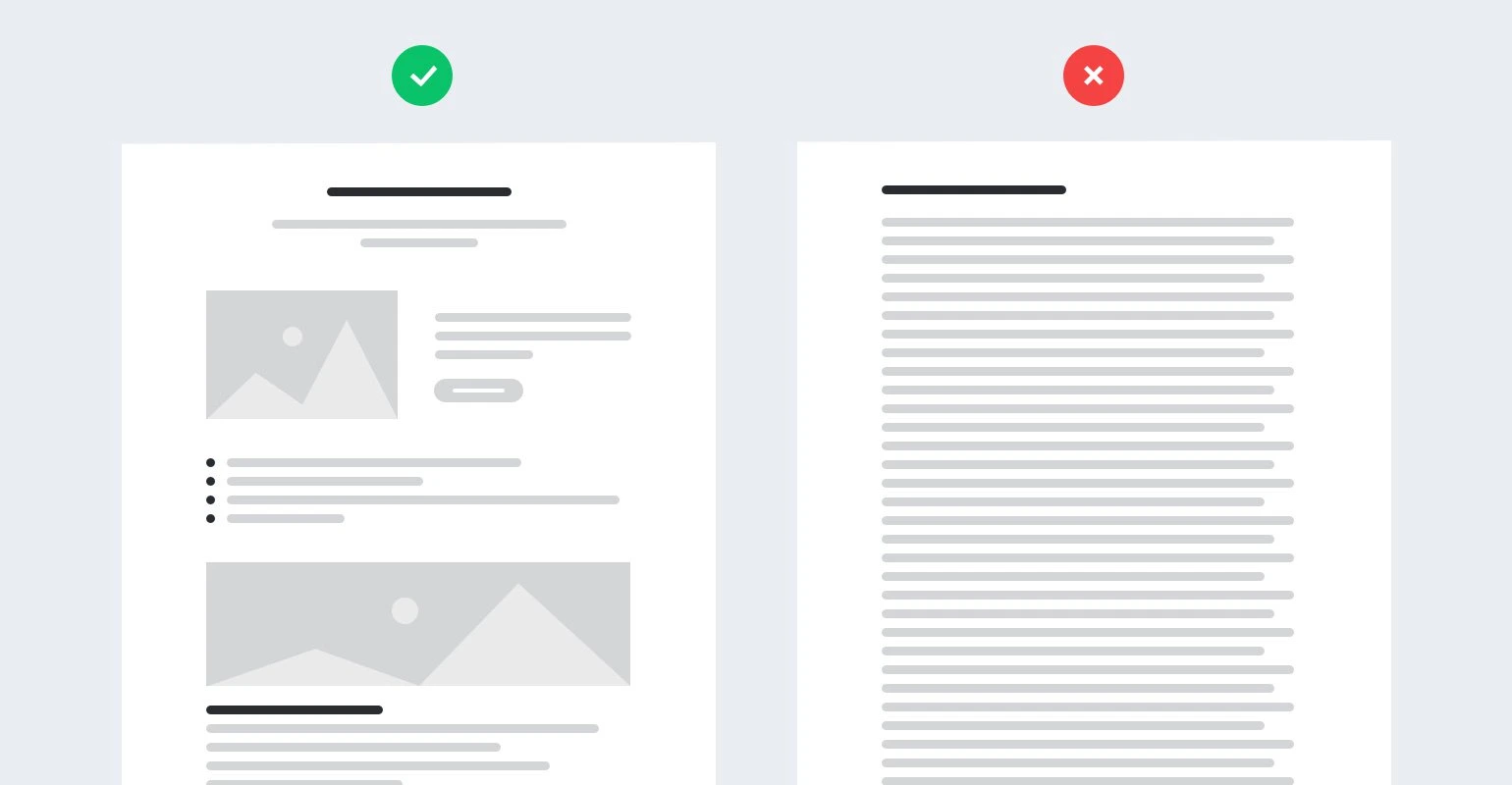
The goal is for the reader to scan your email to see if it's worth diving deeper. This is even more important for mobile devices where the text is compressed.
Using imagery is also an important element. Not only does it break up your text, but images are powerful ways to communicate. You could also use GIFs to add a more dynamic visual element to your email newsletter content.
When considering images, use visuals that add to or complement the main message.
You’ve probably heard the saying: A picture is worth a thousand words. Imagery can quickly tell a story, which is important when people are scanning your content. Here’s more on how you can use images in email newsletters.
4. Tell your readers what to do
The best way to ensure you achieve your goal is to tell your readers exactly what you want them to do. Use direct language and always end your email with a clear call to action (CTA).
Make sure the CTA is easy to find, especially for people who scan. CTAs are so important to your email marketing that we dedicated an entire chapter to creating awesome CTAs.

When you build your content around one message, one target audience, and make it easy to read with a clear call-to-action, you are on your way to creating a successful campaign.
👉 Tip: Typos and grammar mistakes will make your email copy look unprofessional, and they distract the reader from what you’re trying to say. Save yourself a headache and download a free spelling and grammar tool, such as Grammarly, to get your content checked and corrected automatically.
Beyond these fundamentals, you still need to write content in a way that engages the reader. Let's take a closer look at some email writing best practices.
13 techniques for writing email content
We would be lying if we said there weren't some tricks you can try to improve engagement in your email marketing campaigns. Here are our favorite email content hacks:
1. Write an irresistible subject line
This is it—your big first impression! A great email is always preceded by a great subject line. Your subscribers receive a flood of emails every day, so you need a snappy subject line to stand out from the crowd. Here are a few tips to keep in mind:
Be original: Sometimes, it’s the funny or quirky subject lines that generate curiosity
Keep it under 50 characters: Otherwise, your subject line will be cut off
Add emojis: When used appropriately, email emojis can inject some fun and personality into your brand
Use Caps Lock sparingly: Or it can make your email newsletter look spammy and/or unprofessional
Keep it focused and simple: You have nanoseconds to catch your subscribers’ attention, so make sure the message hits home straight away
When writing your email subject line, the best thing is to write several different subject lines and then pick the best one. You could even show them to a friend or a colleague to see what resonates most. Here are a couple of examples from our inboxes, if you need a little inspiration.
Congratulations! You ignored us for so long, you’ve earned $5!
I told you a lie 🤥
🎉 Even More Free Templates + A Special Offer
Culinary legends share their secrets
TODAY ONLY!
Suffocated and trapped 😞
Teach your kids money skills for life 🧒
Spooktacular Halloween Bake Off
Slowing down to speed up ... 🍂
New Series: How Change Happens
You’re not on this journey alone 💜
The unexpected trip that changed my life forever 🌏
The time is now
*Healthy Phone Habits in here 🙌*
Meg I have an amazing dessert recipe for you!😋
Secrets of the social media trade
Did you watch the free training video? 📺
Will I see you tonight?
In Two Days: Get Paid to Travel the World
TSV turns 4! 🎉🎉🎉
Meg, looking for a way to save our planet?
Your Marketing Sucks: Why You Need to Think Local
Fighting for my dream 💪
Going… going… 70% off Ultimate Sale is almost gone!
If you’re still wondering how to write the best subject line to boost open rates for your email newsletter, check out our ultimate guide below:
2. Utilize email preheaders
Email preheaders are the short line of text that immediately follow the subject line in a reader’s inbox. It’s the compelling trailer that piques the interest of your subscriber and encourages them to view the blockbuster hit inside.

To write effective email preheaders, take the common themes and pain points covered in your email content, then use that information to craft a short, attention-grabbing message that resonates.
You can also try including keywords or other elements that are known to increase open rates, such as questions or numbers.
Finally, conduct A/B split tests to determine which preheaders perform best with your audience. Use that data to improve your copy with each iteration.
3. Create a feedback loop
When you’re engaged in a conversation, it’s rude to do all the talking. Healthy dialogue has a balance between sharing and listening. Asking questions within your email content is a good way to get your readers thinking. But an even better hack is to allow them to respond. There are two ways to pull this off: ask them to respond directly to your email or provide a survey link.
Learn more about sending email surveys in this article:
If you want to motivate your subscribers to engage with the survey, you could enter them into a prize draw or offer them a discount code, just like Anthropologie did in the example below.

Check out this article for more examples on how to use interactive content in your newsletters.
4. Heighten the urgency
Encourage your email subscribers to take action right away by offering something of value with an expiration date. One fun idea is to add a countdown timer and create a series of emails that lead up to the final deadline. You can also build urgency through the way you write things.
Author Rachel Caine has created this beautiful email newsletter for bookworms, and she adds urgency using sentences like ‘New books are waiting for you!’

5. Use psychology to your advantage
Time for some mind play! There are tons of psychological tactics that you can use in your email newsletter content, including:
Fear Of Missing Out (FOMO): Create an enticing promotion, an event or a new product, but for a limited time only
Add pictures of faces: People will subconsciously place more trust in your content if they can see you and/or your team
Use social proof: Add testimonials and reviews to your email to spark positive feelings toward your brand
Include the word ‘free’: It’s hard to resist this psychological trigger, especially because it requires zero financial commitment
A great example is by Dr Tiesha Moore, a life and wellness coach. She kicks off her welcome email by calling her new subscribers ‘world changers’, instantly making them feel special. You can see a fun interactive video of her embedded in the email, which builds trust and authenticity. Finally, she makes her subscribers feel unique, saying that while ‘most people’ would fail to achieve clarity, ‘you’re not “most people”!’
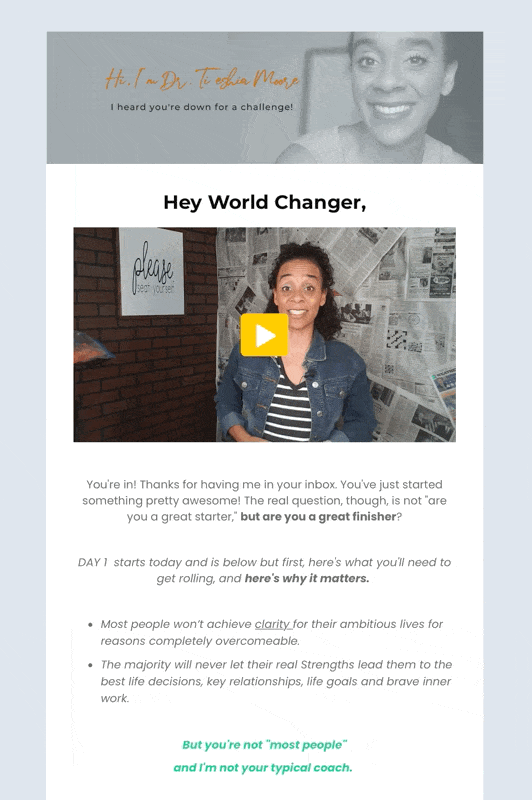
Check out some of these other welcome email examples, if you need some fresh ideas!
6. Incentives are your friends
You’ve written a good email, and now you need some bait! The inbox competition is fierce, so give your subscribers a little extra persuasion to open your email. Here are some incentives you could include:
Special discount or promotion code
Free delivery
PDF guide
Free online course
Printable coloring sheet
Downloadable journal or tracker
Stock images or videos
Podcast
Private Facebook community
Social media templates
We love Emma Lemke’s email newsletters: they’re fresh, minimalist and full of relevant content. In this email, she shares free access to her online training course, which people can sign up for by clicking on the CTA button, and accessing it via the landing page. Using incentives and freebies can add value to your email content and entice new subscribers!
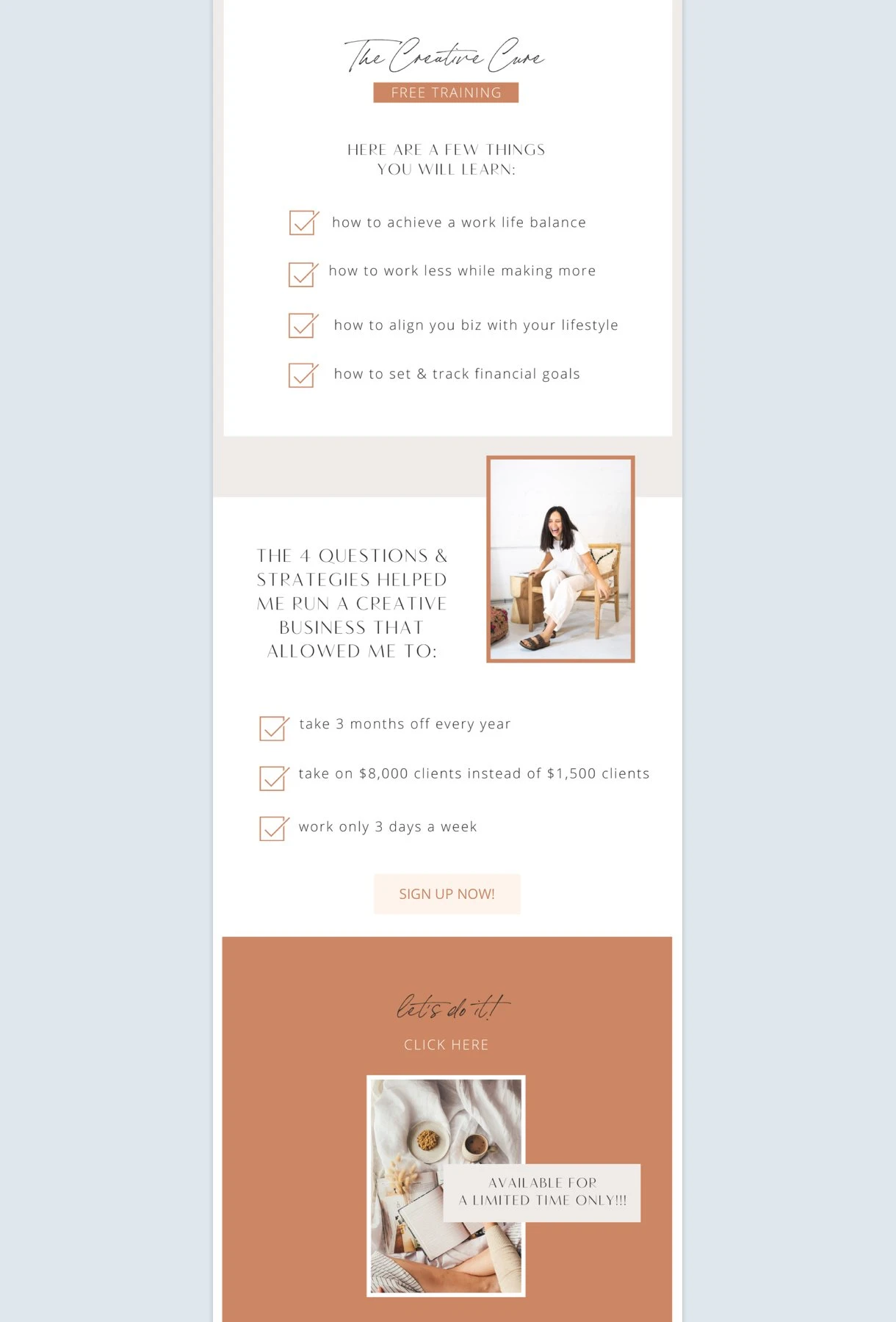
7. Personalization, personalization, personalization
How would you feel if your friends never called you by your name? Or if they forgot your birthday? It’s the same with your email content!
Every email marketing strategy should include personalization, because it’s such a quick and easy way to connect with your subscribers. If you’re still not sure, here are some digital marketing statistics for you to consider. 88% of users agree they are more likely to respond to an email favorably to personalized email messages, yet 53% of email marketers don’t use any segmentation or personalization in their email campaigns at all. This gives you a unique window of opportunity!
Take a look at this email below. If it didn’t greet the subscriber by name, it would just be another generic email in their inbox. But because they’ve personalized their email content, it’s a direct invitation, one which the subscriber is far more likely to respond to.

Personalization can be much more than a name. In MailerLite you can use features like dynamic content, segmentation and automation to personalize your content from creation to delivery.
Discover all the personalization tools you can take advantage of in MailerLite:
8. Keep it sweet n' simple
You know the saying—don’t use two words when one word will do! It can be tempting to go overboard, but the clearer your email is, the more it will stick in your subscribers’ heads. They are bombarded with content all day, so you need to cut through the chaos with a sweet n’ simple message.
Take inspiration from At Home With Ray, a blog and e-commerce store. They send a standout, unexpected message to their subscribers ‘We love you tons’, and then share their promotion, with a quick message and CTA underneath.
Less is more!

9. Benefits over features
You’ve probably heard it a thousand times, but it’s always worth a reminder! Features are just facts about your product or service, whereas benefits will give your subscribers a powerful, emotional reason to invest in it.
An easy way to do this is by using direct pronouns, for example, such as in the Goop newsletter below, ‘A few of these easy tricks can leave you with fresh, natural-looking, no makeup radiance…’ Saying ‘you’ as much as possible keeps the email content personal and relatable.
Another tactic is to start your content with an action verb, telling people exactly what they can do thanks to your business. And before you hit ‘send’, have a final read and ask yourself “so what?” The best email marketers create content that matters, and that offers a solution to common problems. Don’t just talk about how awesome you are; show your subscribers how you can add value to their lives.

10. Speak the language of your readers
Like we said before; keep it human! Don’t hold your email subscribers and potential customers at arm’s length—be authentic and let them get to know you. A quick way to do this is to write the way you talk. When you sit down to write your email, imagine you’re sitting down to chat with a friend. Then put those words into writing. You’ll come across as fun, honest and relatable, and your subscribers will be much more likely to engage with your content.
Take this email from Freely in Hope, for example, a charity that supports women’s rights in Kenya and Zambia. They share an embedded video of themselves smiling and laughing, which instantly creates a connection with their subscribers, and their email copy is relational and genuine.
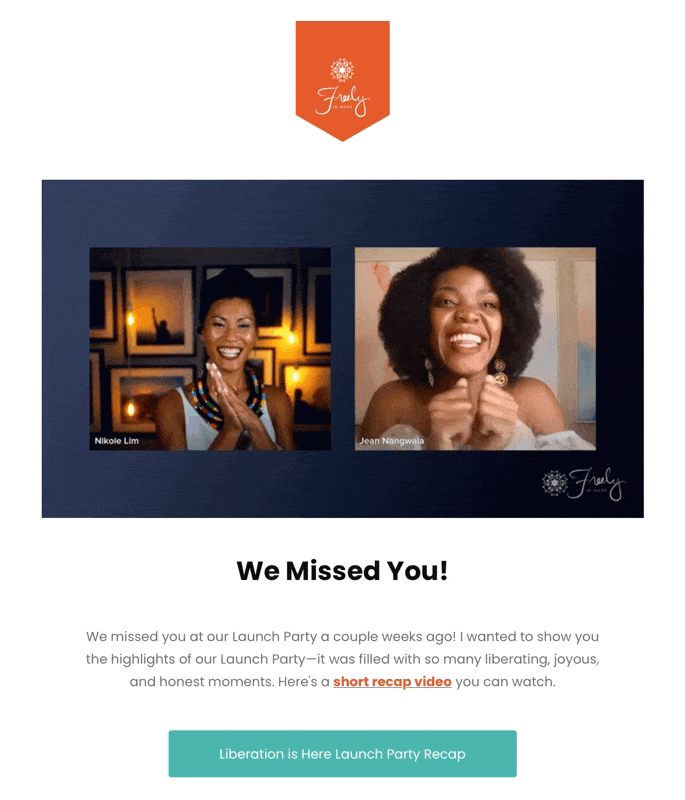
11. Use the P.S. line
When you send an email to a friend, your P.S. line is often the most important point you want them to take away. Your readers' eyes will naturally scan right to a bold P.S. line, so make it a powerful line of copy that achieves your goal. In our MailerLite newsletters, we always finish with a P.S. line, just like the one below.
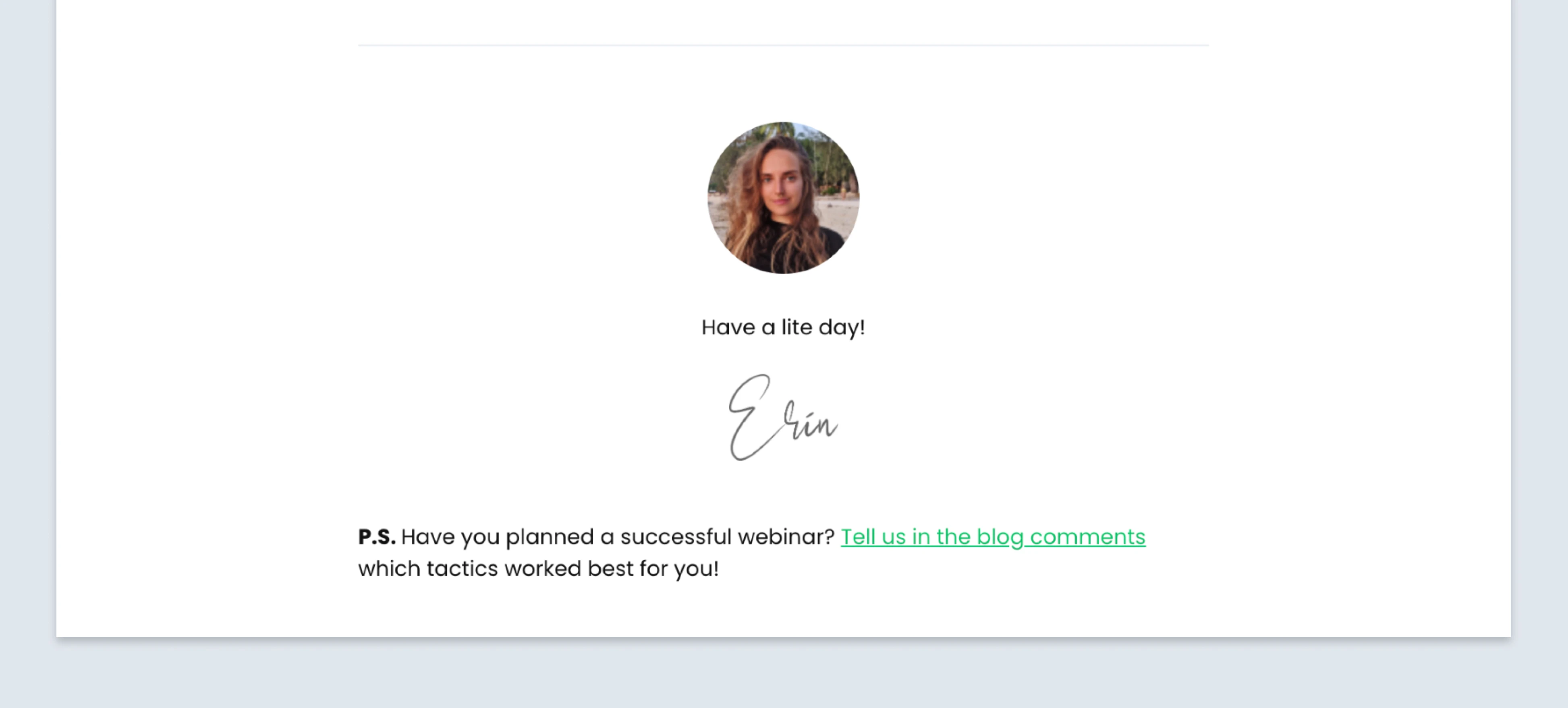
12. Avoid the spam folder
Spam filters are always scanning your content. Don't give them a reason to send your emails to the dark void of spam. Avoid using colorful text, exclamation points and spammy phrases like 'This is not spam!” Here's an entire article on avoiding spam filters to reach inboxes:
Another way to avoid the spam folder is by making sure you have a high-quality email list, filled with engaged subscribers (and no spam addresses). Using an email list verification tool like MailerCheck, you can scrub your list clean of bad addresses and improve your deliverability. Here’s their article on Email list cleaning (The good, the bad and the ugly about email scrubbing).
13. Keep testing
The hardest part about content is that there is no perfect formula. An approach that worked last week might fall flat in the future. Or you can make a minor tweak and have increase engagement dramatically.
At the end of the day, you need to keep evolving your content to surprise and delight your readers in new ways.
Testing your content is a smart way to optimize the messaging before you send it out to your entire list.
There are lots of other tricks you can try to improve engagement, just remember to avoid gimmicks that feel like spam. A good way to check yourself is to ask: "Would I send this email to a friend?”
You would never send someone you love a spammy email, so it's a great way to keep your marketing content honest.
Content is more than the message
So far we've focused mostly on the text of your content, but that is only one part of crafting killer content. You still need to design it!
Most people will look at your email design and within one second decide to skip it or read it. That's a lot of pressure!
Luckily, we spend the next chapter going through email design tips and examples that will help enhance your message and increase engagement.










